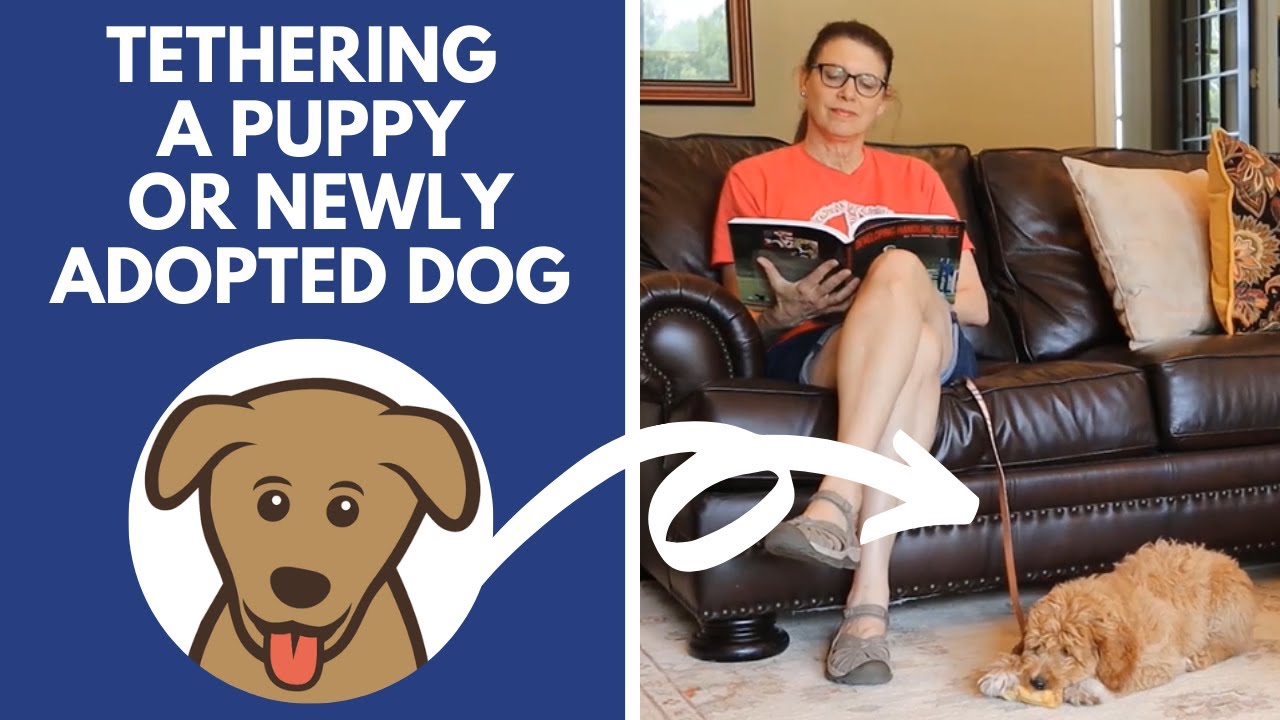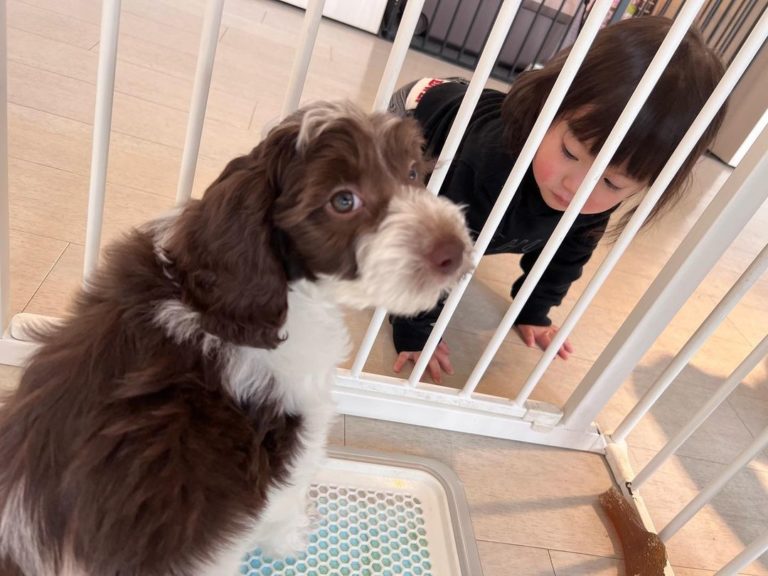Confinement is refereed to the following: Fencing, Kennel Runs, Crates, X-Pens and Tie-Downs
Fencing and Dog Runs
Yard fences should be a minimum of five feet in height and secure enough to prevent escape.
Young puppies should not be left unattended for the following reasons:
- The average yard may contain poisonous plants.
- Many young puppies will chew when left alone and may ingest something that could be poisonous or could cause gastrointestinal obstructions.
- Older pups that are no longer prone to scavenging may be left in a fenced yard when a responsible person is at home to check on the puppy frequently. If the fence is not 100 percent secure, or the puppy is too young to be trustworthy loose in the yard, a kennel run (preferably covered) is useful.
The following are some recommendations for kennels:
- The kennel should be at least six feet wide, twelve feet long and six feet high.
- The kennel run must be clean and dry.The puppy must not be able to dig out of the kennel run. Rubber horse stall mats or large cement stepping stones placed side by side make an inexpensive, puppy-proof, non-permanent kennel floor.
- Shade and water must always be available.
- A warm, dry dog house must be provided for the puppy when it is outside in the kennel.
- A clip should be used to prevent the puppy from accidentally opening the latch.
- Temperatures over 85 degrees and below 30 degrees, including wind chill, can be life threatening. Families should be aware of the weather when kenneling the puppy in yard.
- Female puppies that are in season should not be left in the kennel run unattended.
- Puppies left alone in kennel runs, even within a fenced yard, are susceptible to being stolen.
- Puppies should not be left in a kennel run all day while the raiser is at work or school.
Teaching the puppy to accept being placed in a kennel run for one to four hours at a time (with someone home in the house) is good preparation for coming back to the kennel. Puppies should be introduced to the run gradually, with the raiser close by to reward the puppy for quiet behavior at first. Giving the puppy a novel approved toy or bone will help it settle in the run. Feeding some meals in the run will also give the pup a positive association with being confined.
The Crate
See post “Crate Introduction”
A crate is an excellent aid in teaching proper home behaviors and containing the puppy when it cannot be supervised.
- The crate can be of the plastic airline type or a wire crate. The plastic crates are probably best with a young puppy for ease of cleaning.
- The crate should be large enough for a puppy to stand up, lie down and turn around in it, but small enough so that a puppy does not feel comfortable soiling in it. Too big a crate will allow the pup to sleep in one end and use the other as a toilet – defeating the purpose of crating. Some breeders have different size crates to loan out as a smaller crate facilitates housebreaking.
- The crate should be kept clean and dry.
- Approved toys such as Nylabones TM can be placed in the crate with a young puppy.
- Bedding such as newspapers or blankets should not be placed in the crate with puppies to avoid ingestion.
- Puppies should not be left in a crate for more than four hours maximum other than overnight. It is not acceptable for the puppy to be crated all day (even with a lunch break) while the raiser is at work or school.
The X-Pen
An X-pen (exercise pen) is a portable pen that consists of wire panels that are connected together. When not in use it can be folded up and readily stored. When set up it can be formed into a circle or a square. X-pens come in 24, 30, 36, and 48-inch heights. The minimum height of the pen should be 36 inches. The correct size (spacial wise) would depend on the age and size of the dog. Older and bigger puppies needing more space due to their body size. Any pup over 25 pounds should be monitored when using the X-Pen for several sessions to be certain the puppy cannot escape or collapse the barrier, or caught themselve injury. Most puppies will respect barriers and not test them, but it is always wise to err on the side of caution when leaving a puppy unattended.
- X-pens should be used in the same fashion as a tie-down – in a supervised situation only.
- X-pens are useful to close off an area of the house (e.g., the kitchen) or for making a large area smaller. This can limit the pup’s access to puppy-proofed areas.
- X-pens should not be used in place of a run or a securely fenced yard, as unsupervised puppies can get hurt by getting caught in the opening or between bars.
- X-pens can also topple or collapse. To use the pen correctly, it should be secured to a wall by bungee cords or straps attached to eyebolts.
The Tie-Down (Tethering)
The tie-down is used to teach the puppy to calmly accept remaining in one place. It is often a convenient alternative to an x-pen or crate. The puppy should never be left unattended on a tie-down.

- Tie-downs are plastic covered metal cables with clips on each end – one for the pup’s collar, one for a ring in the wall. They should be at least 30 inches in length, long enough to permit movement. Your puppy should be able to stand and turn around comfortably.
- Tie-downs should be short enough to prevent tangling and to discourage relieving. If the pup is tethered with too much freedom it may relieve indiscriminately.
- Too long a tie-down may cause injury if the pup suddenly runs to the end of it and gets jarred.
- The leash should not be used (even temporarily) for a tie-down. If a pup chews on a leash it may become a habit.
- A safe, visible spot should be selected to attach the tie-down. Good places for fastening a tie-down are into the studs in a wall, to a couch, a heavy table or bed.
- The tie-down should be in an area where the puppy can be observed 100 percent of the time.
- Ideally there should be several secure places to attach a tie-down in the home. (Such as a table desk leg)
- The puppy should not be attached to the tie-down until it has been in the home for several days and is comfortable on leash and knows how to take food politely from the hand.
- The first few times the puppy is put on the tie-down the raiser should stay right next to the puppy and quietly reward it with kibble for calm behavior (see documents “Food Rewards for Calm Behavior” and
- “Teaching Settled Behavior in the Home”.
- The puppy should be given an approved chew toy when the raiser leaves the pup’s side.
- Care should be taken to ensure the pup knows it is tethered – the raiser holding onto the tie-down and gradually letting go prevents the pup from bolting to the end of the cable and jarring itself.
- The raiser should stay close by and occasionally hand the puppy a food reward when it is relaxed.
- If the puppy whines or pulls on the tie-down it should be ignored.
- Introduction should be for short periods with the raiser close by when the household is not busy.
- Distractions will add to the challenge of teaching good tie-down behavior.
- The puppy should not be released from the tie-down unless it is calm and quiet.
- If the puppy does not accept the tie-down after several days of introduction, the leader should be consulted.

